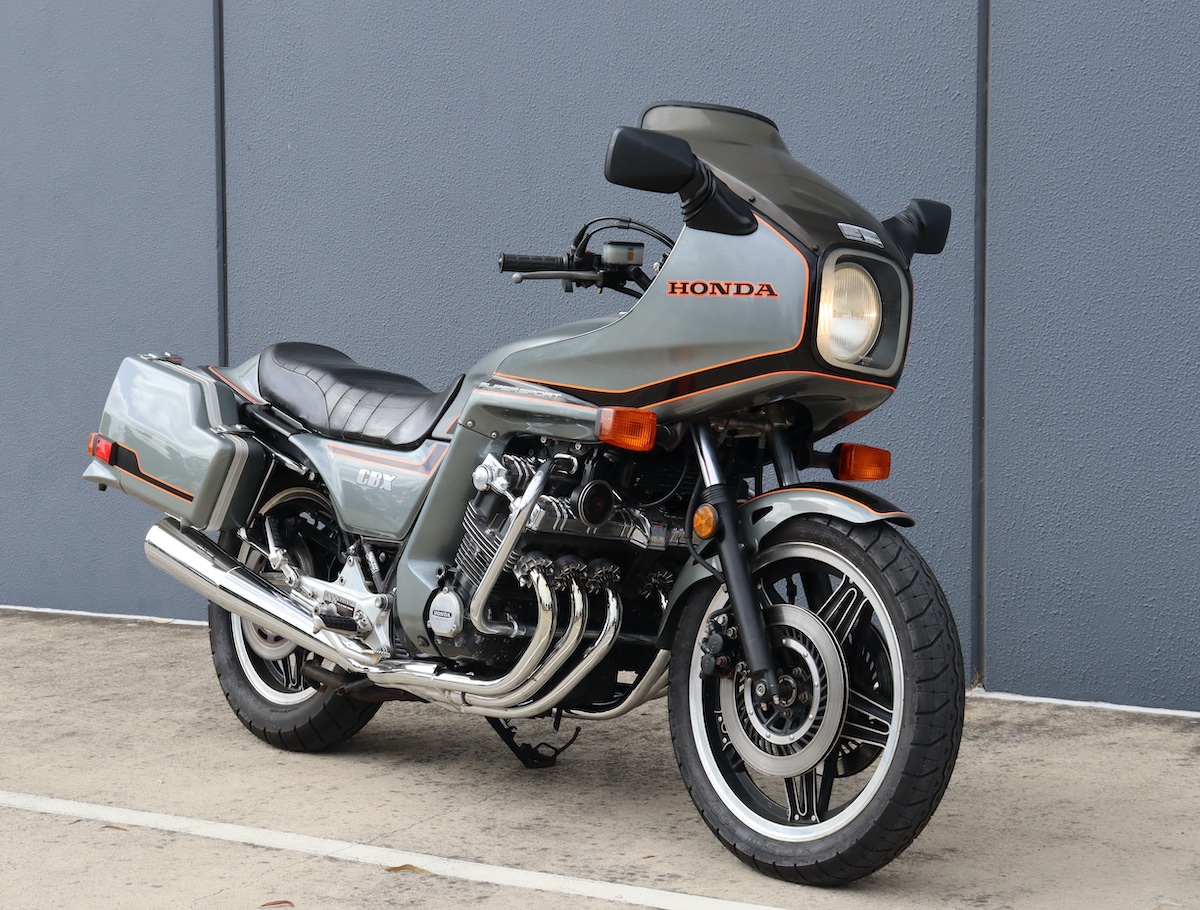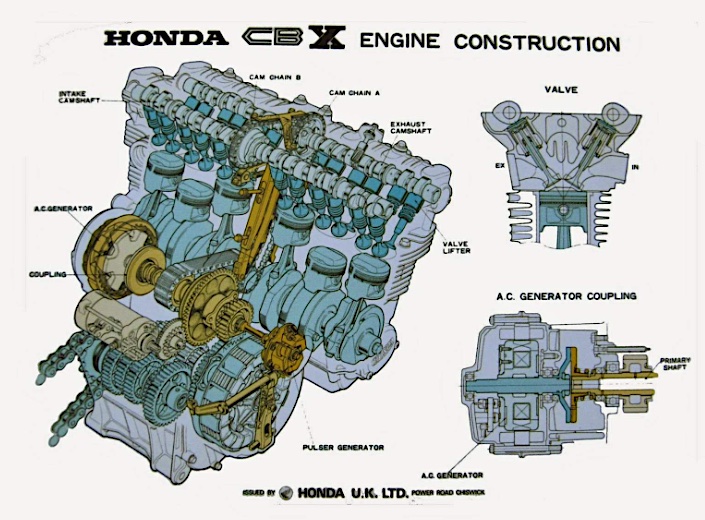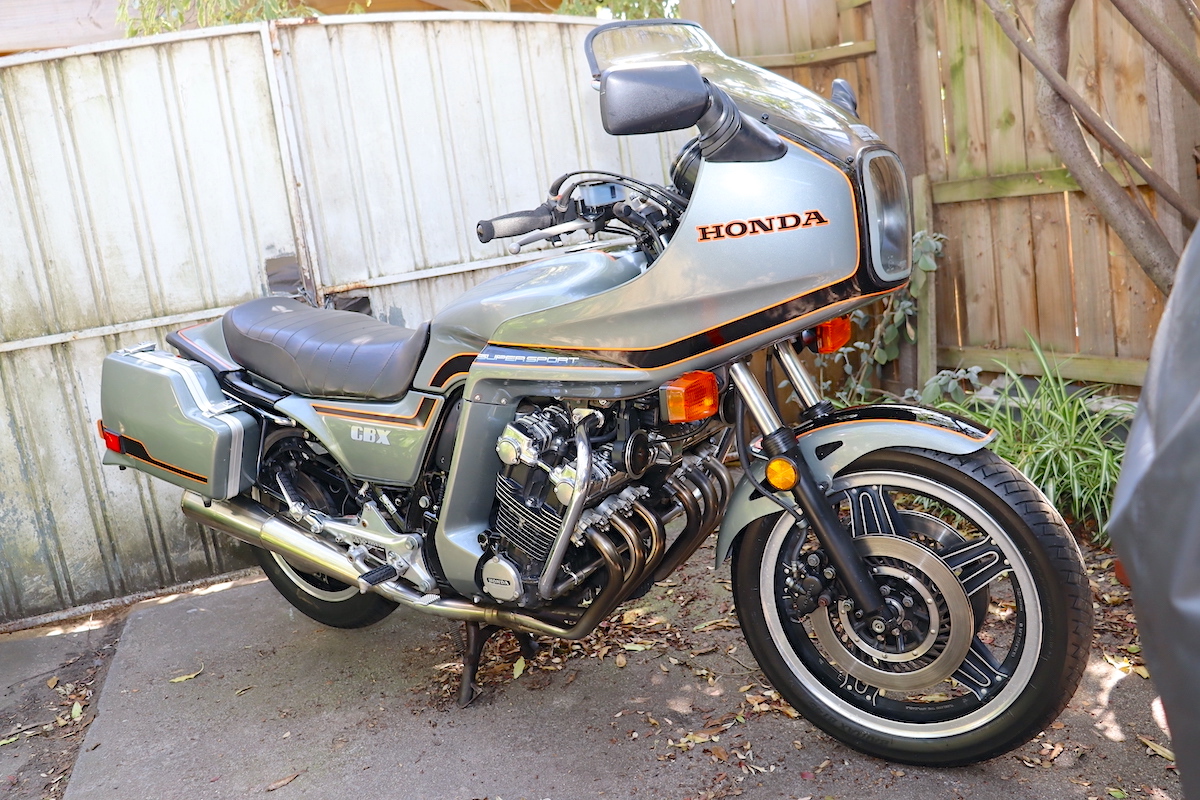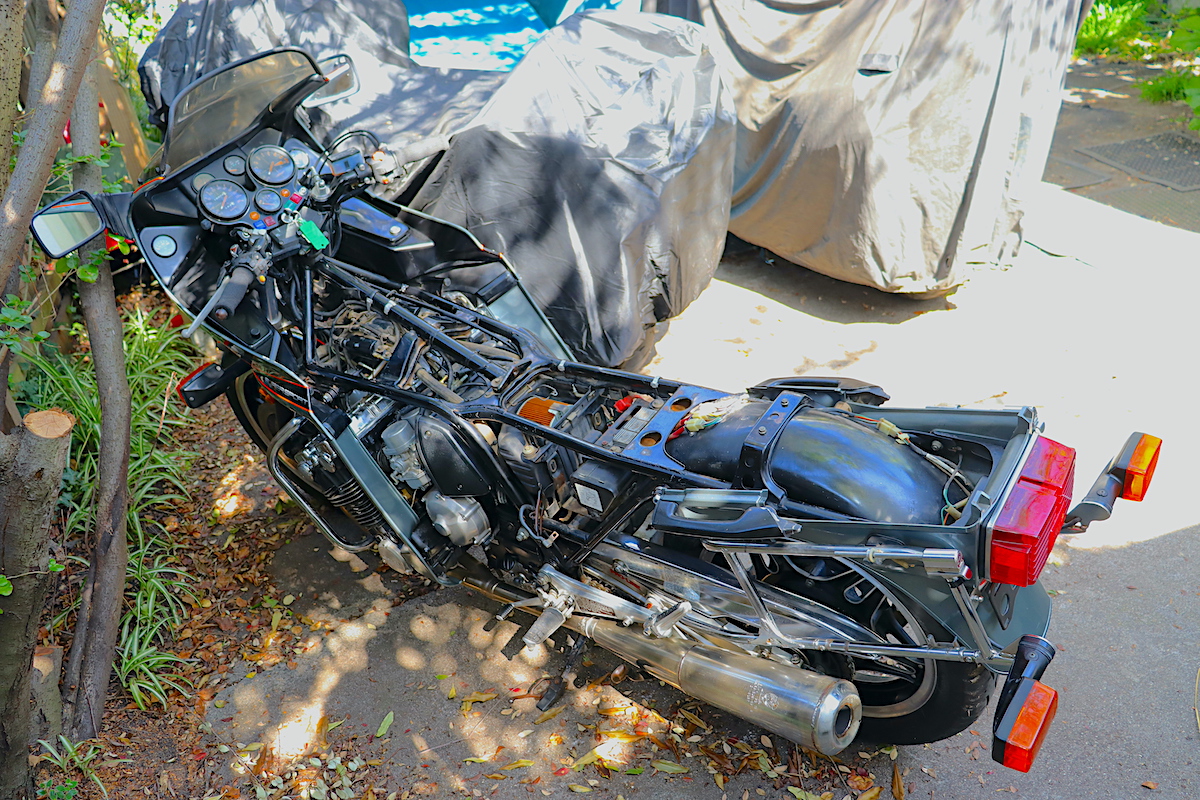Motorcycle Investor mag
Subscribe to our free email news

Six Runner
Getting the 1981 Honda CBX1000 on the road
Bought
at auction, this old CBX six has had a colourful
life and proved to be a bit of a project to get
back on the road...
(Feb 2024, Guy 'Guido' Allen)
It all began with an
unreasonable urge to add a straight six to the motorcycle
shed and the model had been narrowed down to a CBX1000
Honda.
Why? Love the Benellis – or the idea of
them – but I didn't want another seventies Euro project
added to the already complex mix. Kawasaki? A nice idea,
but for yours etc they don't hold quite the same appeal as
an air-cooled six with Honda's often quirky sixties GP
racing history behind it.

So we have it narrowed down to a series. Do we go first naked model circa 1978-79 (above), or second-gen faired generation of 1981-82? Two factors swung the pendulum in favour of the latter: a first-gen naked bike costs 50 per cent or more over its later equivalent and ends up as an investment vehicle; Plus I liked the idea of having the big 'grand tourer' version as it works with the sort of riding I enjoy.
Naked versions are very much on the
international collector radar at the moment and are
growing in value. Meanwhile a well cared-for Prolink, or
CBX1000B or C, will more than likely hold its value.
Honda's CBX1000 six was publicly launched
in late 1977 and an unexpected delay in production meant
it took nearly a year for it to reach the market – so
second half of 1978 for the 1979 model year. It pulled
very positive reviews, but the delay hobbled it in the
showroom. There was a lot going on at the time, such as
the launch of Yamaha's XS1100
and Suzuki's GS1000 series.

Add in the obvious complexities involved
with a 24-valve inline six, with a carburetor per pot, and
you can understand how a fairly conservative market might
have got a little shy. The first-gen pulled only modest
sales, and so Honda worked on a second that it could shift
into a different market segment.
Rather than just dress it up in new
bodywork, the company put some serious effort in. It
risked knocking a few horses off the top-end to broaden
the midrange and made some small but significant
alterations to the carburetor set-up.
Suspension at both ends was upgraded,
moving from twin-shocks to a Prolink rising-rate monoshock
at the rear. Steering geometry was altered to slow it down
and the wheels were changed over.
When it came to brakes for a now heavier
machine, Honda's showpiece was the fitment of ventilated
discs cast in-house (an impressive undertaking at the
time) combined with an upgrade to two-piston calipers all
round. The previous model was effectively running Gold
Wing brakes with solid discs worked by single-piston
calipers.
The in-house panniers were sculpted to
fit the machine and came with a key-operated one-off
mounting system that worked well.
And then there was the Bol d'Or-theme
fairing, complemented by the long rear tailpiece. It was a
nice try, but the market still wasn't convinced.
In the USA, dealers famously quit stock
for whatever they could get, commonly around 60 per cent
of retail.
And so there we were, a little over 40
years later, with muggins risking a bid at auction on one
of these things. It ended up in the shed.
It came with a cute story. The CBX was
initially sold by Phil Crump Honda in Mildura – yes, the Crump of
international speedway fame. It was owned over the
years by a few people in the district who of course knew
each other.
At some stage, the story goes, the bike was purchased by the wife of one of the gang, who convinced the others to chip in for a restoration including a kangaroo-hide seat. It was presented to the lucky gent as a 50th birthday present.

I got the chance to eyeball the CBX
before bidding and could see it probably needed
recommissioning after a lay-off. It had an aftermarket
exhaust system which was decent quality but was showing
signs of rust. Plus, I wasn't thrilled with the relatively
clumsy pipe bends on the headers (above).

Step one was to do a basic strip (of the
bike) in the back yard and get my head around what we were
dealing with.
Then we did two things: sling it at my
local workshop (the crew at Gassit) and order a bunch of
parts, including a new exhaust system from Delkevic. The
latter is a far better visual replica of the original.
Spares availability for this machine is
mixed. Service parts such as filters are good, but
everything else is patchy.
This turned out to be a pretty big job
and I was fortunate enough to strike a mechanic (Brett)
who was up to the task. In the end, we had to strip down
and clean out the carburetors (a huge undertaking),
replace the plugs and caps, do the usual filters and
fluids, plus rebuild the brake calipers and change the
fork seals. Oh, and then there were the tyres, plus chain
and sprockets. We're talking about somewhere around
Au$4000 (US$2600, GB£2000).
The bill didn't come as a big surprise.
While you'd hope you could just collect the bike, throw in
fresh fluids and ride off into the sunset, machinery at
this level that's been left to sit is going to cost money
to recover. I have a mate in the classic car world who
likes to remind me (when I grizzle about the running costs
of my V12 E31 BMW) that when you get into high-end
machinery, no matter how small the purchase price, you can
expect to cop high-end running costs. He's right. The
trick is to keep it down to a dull roar.
There is an upside. I now know exactly
where the motorcycle is when it comes to condition. That
means you can jump on and head off into the boondocks with
a pretty high degree of confidence.
One of the things I did from day one was
fit the biggest capacity lithium battery you could squeeze
in, along with a charging harness. Bikes in my fleet can
easily end up sitting for a month or two, and it's nice to
not have to root around under sidecovers with ageing and
fragile mounts, looking for charging points.
In this case, the lovely CBX is running a
very full instrument cluster, some of which are
aftermarket. In addition to the fairly comprehensive deck
from Honda we have two temp gauges – one for oil and the
other for the head (reading off a spark plug mount). The
latter two are run by the accessory electrical circuit,
which means you need to be absolutely sure you turn off
the ignition all the way. Otherwise you're greeted with a
flat battery, possibly days or weeks later.
One of the other little tricks we
discovered with this model is it runs two fuel taps. The
main is a traditional item that shuts or opens the pipes,
located on the lower left of the tank, while there is a
second vacuum-operated tap under the tank. The latter is
notoriously unreliable and we've bypassed it. However CBXs
will leak fuel if the 'normal' tap is left on, so you have
to be religious about its use.
After all that effort, what's it like to
ride? Holy heck it's big. This thing dwarfs the Hayabusas
in the shed. It's also heavy – teetering around 300 kilos
fully wet according to the stats.
Firing it up is no issue, though it
doesn't run so much as rasp – there's a hackle-raising
sound which is a little like two angry triples, which you
can put down to a combination of air-cooled straight six
and the lack of balance pipe on the current 2 x 3-into-1
exhaust system. Compared to a current liquid-cooled multi,
it sounds raw and potentially explosive.
Like any older air-cooled engine, it
takes a while to get up to temp, so a long warm-up and
then a gentle ride away works.
Once up to speed, it sounds angry and is
silky smooth – a weird combination. Oh, and it's
alarmingly quick. It might be just 98 horses, but that's
enough to accelerate the thing at an appalling rate,
pulling strongly off the bottom end and very enthusiastic
in the midrange. Top end? It keeps making noise and power,
by which time you've realised this is 1980-something and
not 2020-something, so it's determined rather than
stunning.
As for the transmission, this is a solid
effort from Honda for the period. It's pretty slick and
the clutch has a nice wide take-up band.
Pumped up to the right pressures, the
air-assisted suspension works well – on the plush side and
in this case with a fair amount of damping control.
Steering is slow, which I'm perfectly
happy with on something this size. It still responds to
the handlebars on entry and exit, and feels settled
mid-corner.
Braking? Yeah, well, it's fine for the
period and you need to remain aware of what you're saddled
up with. This thing is heavy and, if you're about to fire
it down a sports road, which it will happily do, it has
limitations.
.jpg)
There are bikes in the broad modern
classic sphere or era that are cheaper and more capable
than the CBX – Kawasaki's excellent GPz900R A1 springs to
mind. I ran one not so
long ago and can recommend it.
As for the CBX, it's fun to jump on these
monsters, particularly once they're sorted. They're big,
fast and clumsy by current standards and hugely
entertaining. Oh, and by the way, in this case the
kangaroo-hide seat is still in place...
Here's a brief engine
start and walk-around vid.
Know your CBX1000s

There
are four variants – two naked:
CBX1000Z – approx 25,000 made
CBX1000A – approx 5000 made (easy ID: second-gen 10-spoke
Comstar wheels)
And two with fairing and
Prolink rear end:
CBX1000-B – approx 3750 made
CBX1000-C – approx 2750 made (easy ID:
it has a solid pillion grab rail at the rear of the seat)

Launch prices

Launch brochure (UK)

Two of the above
illustrations are taken from spectacularly huge and heavy
hardbook The CBX Book vol II, by Ian Foster, 2014
(above). Sadly it's no longer
available through the usual retail outlets, but you may
come across it on the used market.
See an earlier
story on the CBX1000 in our shed
And the period
road test of the CBX1000Z in Classic Two Wheels
Specifications
Honda 1981 CBX1000 Prolink
Good
Fast
Huge presence
Loads of engine character
Not so good
Big
Heavy
SPECS:
ENGINE:
TYPE: air-cooled, four-valves-per-cylinder, inline six
CAPACITY: 1047cc
BORE & STROKE: 64.5 x 53.4mm
COMPRESSION RATIO: 9.3:1
FUEL SYSTEM: 6 x 28mm Keihin carburetors
TRANSMISSION:
TYPE: five-speed, constant-mesh,
FINAL DRIVE: chain
CHASSIS & RUNNING GEAR:
FRAME TYPE: steel tube, diamond pattern main section, with
engine as stressed member
FRONT SUSPENSION: telescopic fork, air preload adjustment
REAR SUSPENSION: Prolink monoshock, air preload and 3-way
rebound damping adjustment
FRONT BRAKE: 2 x 276mm ventilated discs with 2-piston
calipers
REAR BRAKE: 276mm ventilated disc with two-piston caliper
DIMENSIONS & CAPACITIES:
WET/DRY WEIGHT: 277/308kg
SEAT HEIGHT: 810mm
WHEELBASE: 1535mm
FUEL CAPACITY: 22lt
TYRES:
FRONT: 100/90-19
REAR: 130/90-18
PERFORMANCE:
POWER: 98hp (73kW) @ 9000rpm
TORQUE: 84Nm @ 7500rpm
OTHER STUFF:
NEW PRICE: Au$5040 + ORC in 1981 (US$3300, GB£2600)
VALUE of a good example in 2024: circa Au$20,000
(US$13,100, GB£10,300)
More on the CBX:
1979 CBX1000A
road test via Classic Two Wheels
Jay Leno video on
the 1981 CBX1000B he's owned since new
-------------------------------------------------
Produced by AllMoto abn 61 400 694 722
Privacy: we do not collect cookies or any other data.

Archives
Contact




